
|

|
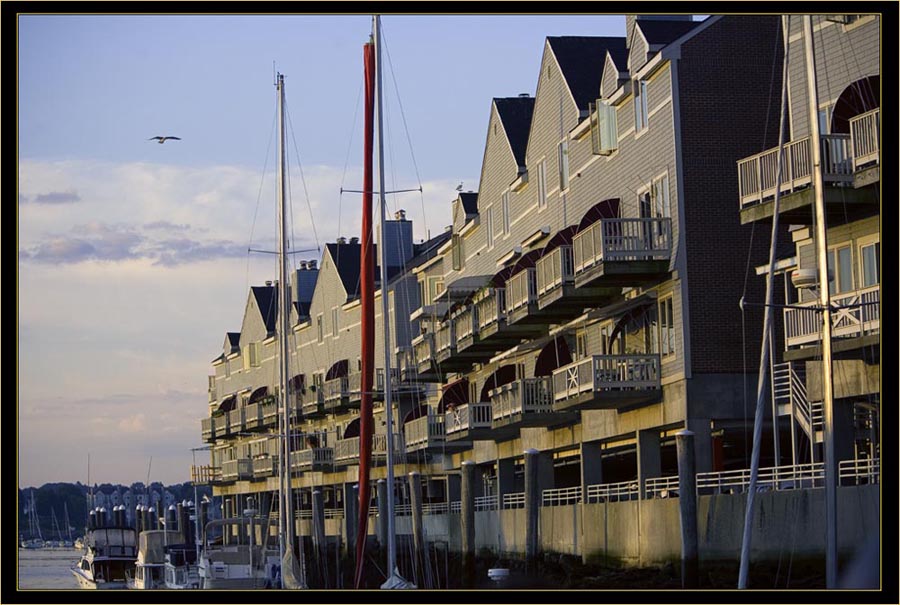
|
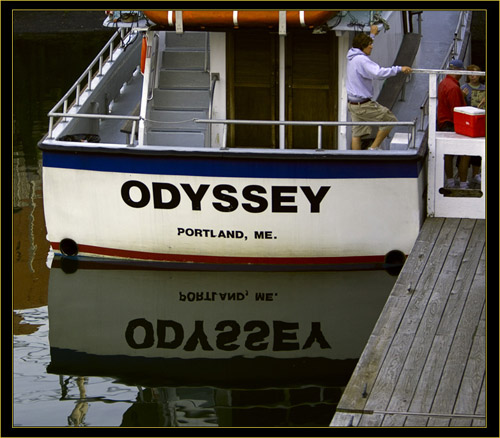
|
Once Paul and I convinced our ladies, Marlene and Linda this would be a fun time should they choose to accompany us, I contacted Anita at See
Life Paulagics and mailed a check for the reservations.
All we had left to do was await the date and keep an eye on the extended forecast and sea conditions hoping for a nice day with calm seas.
Everything was going well and the planning was complete going into the Saturday morning of the event... We had to be at Long Wharf in Portland just after 0500 hours – I think Paul and I both heard about the ‘early hour’ and ‘why did we agree to this’ scenario. After all, we were up before the summer sunrise, but once we were out and moving everyone had a good attitude to face the day. We arrived at the waterfront with time to spare and checked out where the Odyssey was berthed. Once the group was assembled, Odyssey Captain Dan briefed everyone on safety and regulations. Afterwards Paul gave a talk about what we should expect and we boarded for the 0530 departure. Sunrise was at 0514 so we were approaching a premier time photographically - that ‘golden hour’ when the sunlight is soft and warm-toned to greet the day. I planned to take advantage of this as much as possible on the outward leg. |
|
We sat on benches in the upper observation deck area opposite the sunrise. We wished to avoid facing the sun directly in the event we viewed a subject worthy of photographing.
It's not unheard of to lose sight of the beauty surrounding us each day when our work lives and tending to affairs in the normal course of the day become habitual. I wanted to
attempt to see Portland and the environs much like our summer visitors do.
At least this was my intention as I’d been thinking about getting some shots in our local area from seaward and planned to avail myself of this opportunity. I’m really
pleased that I did as we cruised by places I’m quite familiar with and got the chance to look them over from another perspective. My photographic effort was divided
into various categories – scenic shots, birds of course and always, plus anything else we may view on the waters – whales, seals, etc., and perhaps some people shots on board.
Linda left it up to me as to the choice of lenses to take aboard. She was using her Canon 30d body with a Canon 70~300 f/4.5-5.6 Diffractive Optics, Imaged Stabilized lens. I selected this because being of a specialized design it had a good bit of reach while being neither heavy nor particularly long when extended to 300mm. I had my Canon 5d body and carried several lenses including a 70~200 f/2.8L Imaged Stabilized lens with a 1.4X extender. With this I could shoot at 280mm at f/4, a fairly quick scenario for wing shots. The second was my trusted companion lens, the Canon 400mm f/5.6L. This would generally be my first choice for this type of shooting when unable to use a tripod except it isn’t imaged stabilized and I wasn’t certain how critical this may have been. My plan was to test shoot it but once we got going I never did exchange lenses. I used the 70~200 all day and shot an 8GB card almost to capacity – nearly 500 raw format images. My foremost lens choice for bird imaging is my Canon 500mm F/4L, extended to 700mm and used on a tripod. I truly missed the reach this lens provides on this trip but it isn’t really one that can be handheld. |

|
The Portland waterfront really is an integrated mix of work and pleasure craft; both can be readily viewed everywhere around the harbor.
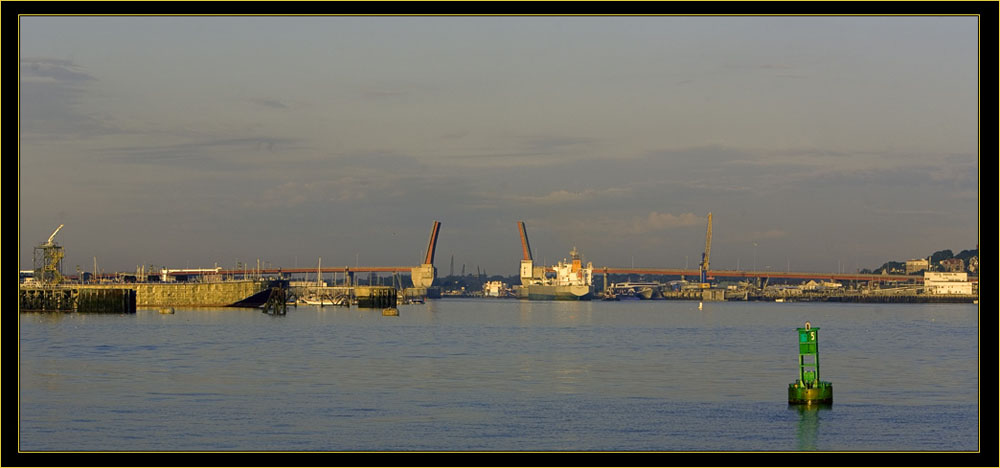
|
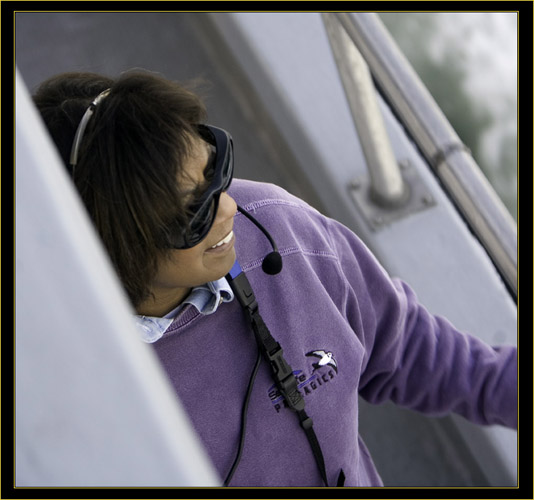
|
So we were on our way to look for birds offshore. The sea was relatively calm and the weather was much improved over the early week forecast – it turned out to be a fine day.
Everyone kind of settled in, listened to the commentary over the loudspeakers and enjoyed the morning. Not much in the way of birds or sea life was missed between the folks
on the bridge and the various spotters stationed strategically on board. I checked the settings on both cameras and took a few test exposures to adjust the histrograms.
I no longer carry a light meter and use a ‘right adjusted’ histogram method, where the exposure compensation is pushed to allow as much information into the right zone of
the histogram without clipping or blowing out the highlights. I won’t get into this much here, but if you do not adjust to use the right fifth of your histogram about
half of the available encoding levels of your camera are not being utilized.
The light was phenomenal and I set about enjoying the beauty of
this section of our Maine coast.
There are two things I’d like to share while we digress for a moment. One is that Anita informed me she and Paul were in Maine celebrating their anniversary. She indicated this when I first talked with her while making the reservations and stated she was really looking forward to the trip. So ‘Happy Anniversary’ to Paul and Anita! The second is that I’d like to share some of the sights we had on this fine morning heading out to sea. The following views hopefully ‘speak for themselves’ although the full resolution versions really do them justice compared to these significantly reduced web versions. So without further ado, find below a few images to have a look… |

|
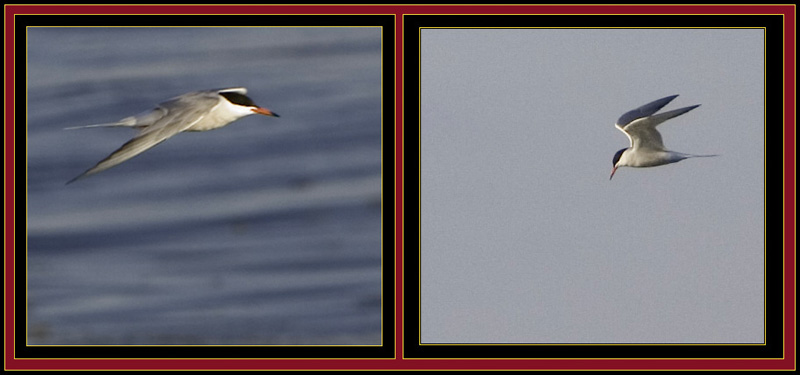
|
They certainly pegged this correctly – there were many terns in the area and Odyssey reduced speed as we looked around. I did little imaging at this juncture, just a few
shots over the rail in front of me. At 280mm reach, these fast paced Common Terns weren’t close enough to obtain much of an image scale and my field of view was somewhat limited.
Even at that I found I had to be careful as my lens with the hood attached was long enough to present a problem panning. Following a bird in flight could get you close
enough to whack your neighbor as you pivoted, let alone the fact that if the vessel lurched or you lost footing with both hands on the camera you could easily fall
down or worse in my case, fall on somebody - I’m a big guy and doubt this would be easily forgiven... I was lucky in that Paul and Linda were sitting next to me on either side so at least nobody was disturbed I didn’t know well.
|
|
Derek and Paul pointed out the various birds and sea life. They also developed a species listing and count as we cruised. I often wondered how Derek can do so well with this
in the times I’ve been along in groups with him, but he is fairly masterful with this endeavor and keeps count of all kinds of sightings. I generally don’t keep notes except
photographically although my friend Paul sometimes does. When I do I usually bring my voice recorder along but didn’t carry it on this trip. Derek's field notes on Maine Today
details the findings for the morning with his comments & some photographs. Nicely done Derek this is a great blog!
At right - a Laughing Gull in pattern around Odyssey.
|
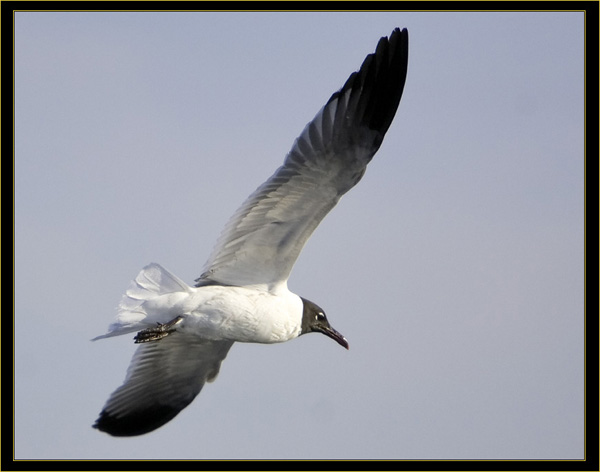
|
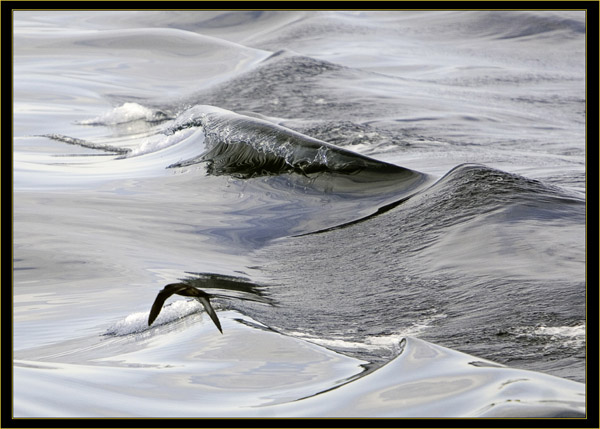
|
Not long afterwards as Odyssey continued seaward the crew started chumming over the stern to generate interest of the local bird population and to draw
the various species in. Derek made some comments about the chum, consisting of chopped herring, mackerel, oil and popcorn provided courtesy of a local
movie theatre. At first this chumming didn’t bring spectacular results but this was soon to change. Later he commented that this particular day was
exceptional as the calm seas prevented the chum slick from quickly dissipating. The amount of activity that was generated by these efforts was really impressive.
At left a Sooty Shearwater glides over the waves. |
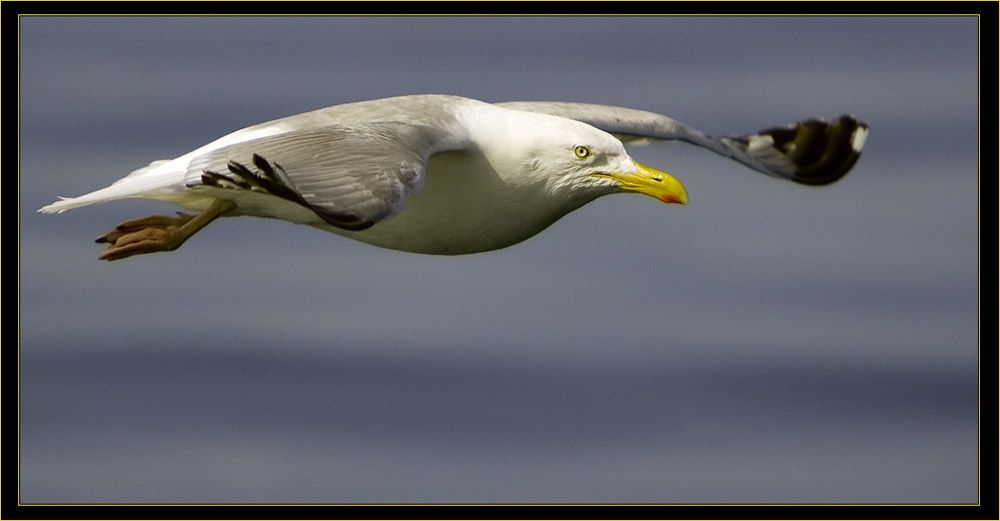
|
|
This was my first experience with this type of effort. I’ve been on plenty of vessels for various reasons but this was my first attempt where photography at sea
was the goal of the endeavor. I would comment that imaging birds on land can be challenging in itself; add a rocking vessel, poor footing, along with the wind and one
has an altogether different experience. We thanked our lucky stars that the sea was calm compared to what could have been.
Paul indicated that when you view a seal nose up as in the upper right image they are generally
napping. In the bottom image this seal has rolled over and the creatures whiskers can be seen. |

|
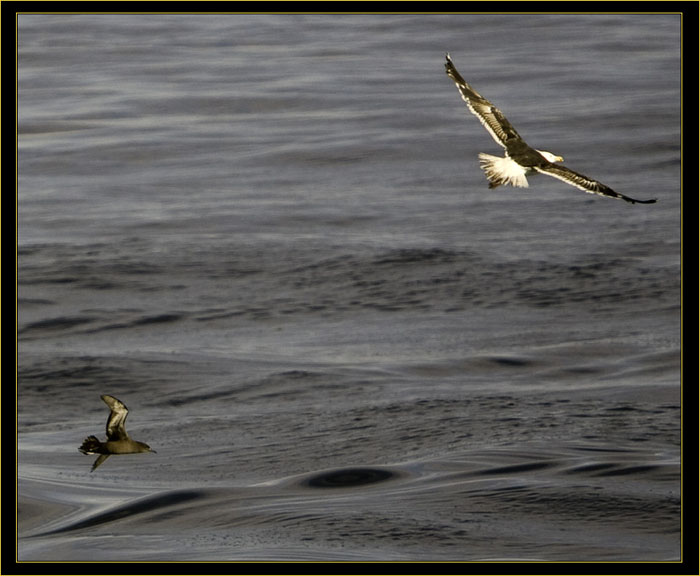
|
I learned several things quickly once the chumming commenced. The first was that I was in a poor location with my field of view sternward blocked.
The only recourse I had was to shoot directly in front of me where there was little or no activity. The second was that even had I been at the stern rail
on the upper deck, shooting from this location presented issues as learned when I gave it a try. I wasn’t long before I recognized that the best opportunities were
when the birds were near or on the water in the chum stream – a difficult angle from my location. They moved in & out quickly and there were, trust me on
this – many birds and no semblance of traffic control. There were birds flying everywhere from all directions at once dodging, weaving and scrambling to
get at the chum. The spotters spotted, folks onboard called out sightings as they occurred, Derek and Paul (these guys were great) all the while called
out the various birds over the intercom and their locations so they could be viewed. I know what you’re thinking – no big deal right?
At left a Sooty Shearwater and Black-backed Gull share the same air space. This was exposed at a calmer moment away from the vessel... |
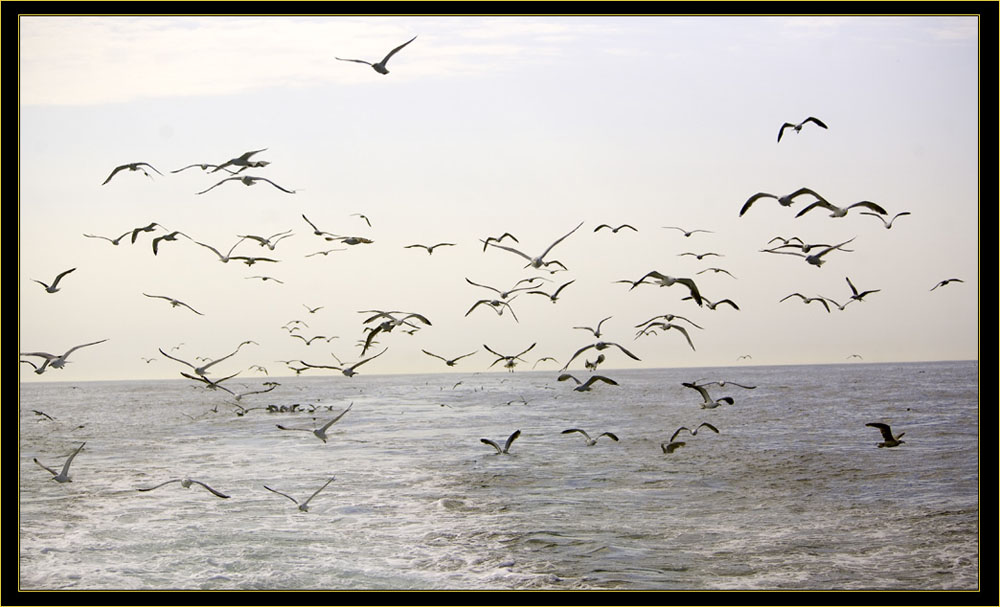
|
|
For the last hour or so I hadn’t really gotten into the swing of things and was a bit disappointed about how this was shaping up – not the overall trip,
just my imaging effort, but now I was ‘picking up the pace’. Paul and I discussed the situation and I concluded the best course of action would be to concentrate
on birds that I could tell weren’t gulls when they broke the confines of the gaggle. Yes I know, I know - why is this an issue one would suppose? Well,
I’d say my recommendation would be get out on the ocean and spend several hours
with a +/- 300mm lens following a bird or birds as they fly erratically up, down, sideways, etc., in rapid succession through your viewfinder, with both hands on the camera, while attempting to retain balance,
check your camera settings and obtain a focus lock - you’ll
learn quickly enough if you don’t barf over the rail first… After you’ve done a bit of imaging in this fashion then we can discuss the
intricacies of this endeavor once we're both on the same page... Keep in mind the purpose here is to isolate individual birds, hopefully photographing species you’d only locate in this environment – far offshore.
As I started to get into the swing of things I gained a whole new respect for imagers that do this regularly. I don’t know what I would have done in a running sea with one hand required to clutch the rail while managing the camera & lens.
However I would comment, I was having fun!
One of the end results of my new strategy was I came home with what I consider a fine collection of Greater Shearwater images... About this time my concern was the most likely prospect from this trip would be a file of out of focus images to review. I’m far from being new at bird imaging but this scenario was a bit different... All things considered though, I was/am more than pleased with the group and the 'keeper' ratio was much better than expected - guess I didn't give myself enough credit. Although a few of the new species images are marginal (these are what I consider 'what we viewed/identification' shots), six new birds were added to my Bird Images Index from the morning and I consider that most successful. I especially like this Greater Shearwater image and consider it one of my best of the day.
|
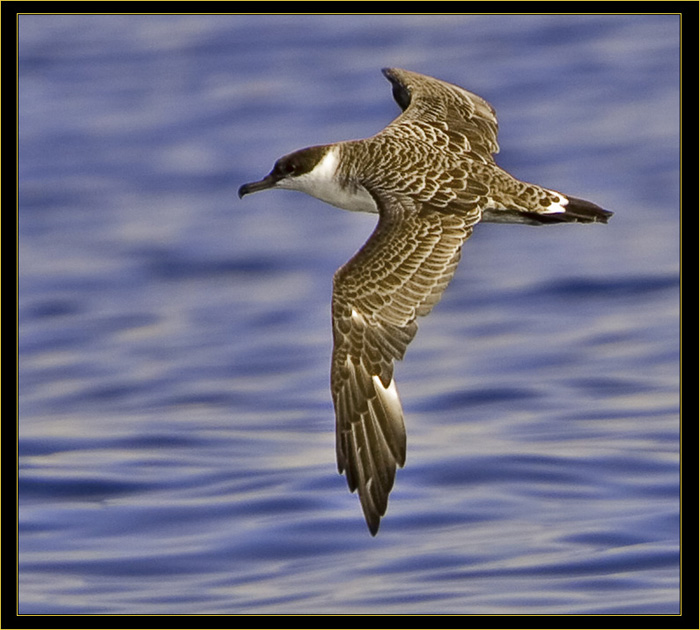
|
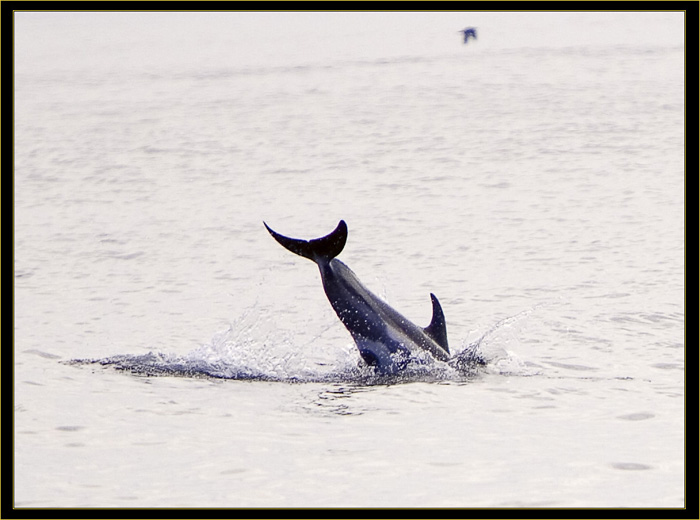
|
By the time we arrived at the limit of the seaward leg, approximately 25 miles offshore, I’d moved below to the main deck. I relaxed a
few minutes in the enclosed cabin with Paul and Marlene (Linda remained topside a bit longer) and although one can never put your camera down without
some way of protecting it, I got the strap off my off my neck for awhile. After this short period to re-group and compose I checked out various
other places near the stern to seek out imaging opportunities. I would state that in my case the second half of the voyage was superior in most regards to
the first. I didn’t go onto the upper observation deck for the rest of the day. Our shipmates were spread out and everybody was doing their own thing
aboard.
One of a pod of Atlantic White-sided Dolphins we spotted in deep water. |
This article would become much longer if I posted examples of all the gull images collected. At least there's not a great deal of text to peruse...

|
Note: Derek Lovitch, one of the premier birders in the known universe, feels strongly that referring to gulls as ‘seagulls’ is rude and demeaning… It is in his honor that I corrected the text in the above photo template...
|
We’d viewed some seals, dolphins and porpoises and Paul announced a sighting of a Minke Whale, which everyone was excited about. Overall, I had three excellent
sightings of the Minke all brief, with no chance to get the camera up for an image. This whale didn’t remain above the water long at all, a quick
breath and it again submerged. We hung around a bit as the Captain maneuvered the vessel towards the last sighting location hoping to see it again
but this was not to be.
Also near this location numerous Atlantic White-sided Dolphins were spotted, at least this is what Paul indicated they were and he is clearly an expert in these matters. Linda stated she could see a group of around thirty or so from the upper deck. I didn’t realize that many individuals were in view but both of us got some respectable photographs of them. Atlantic White-sided Dolphin views - they were beautiful in the sparkling sunlight.
|
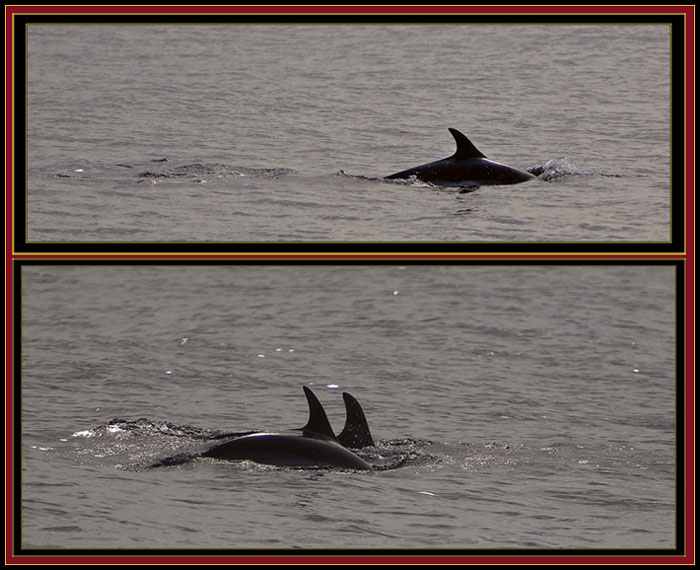
|
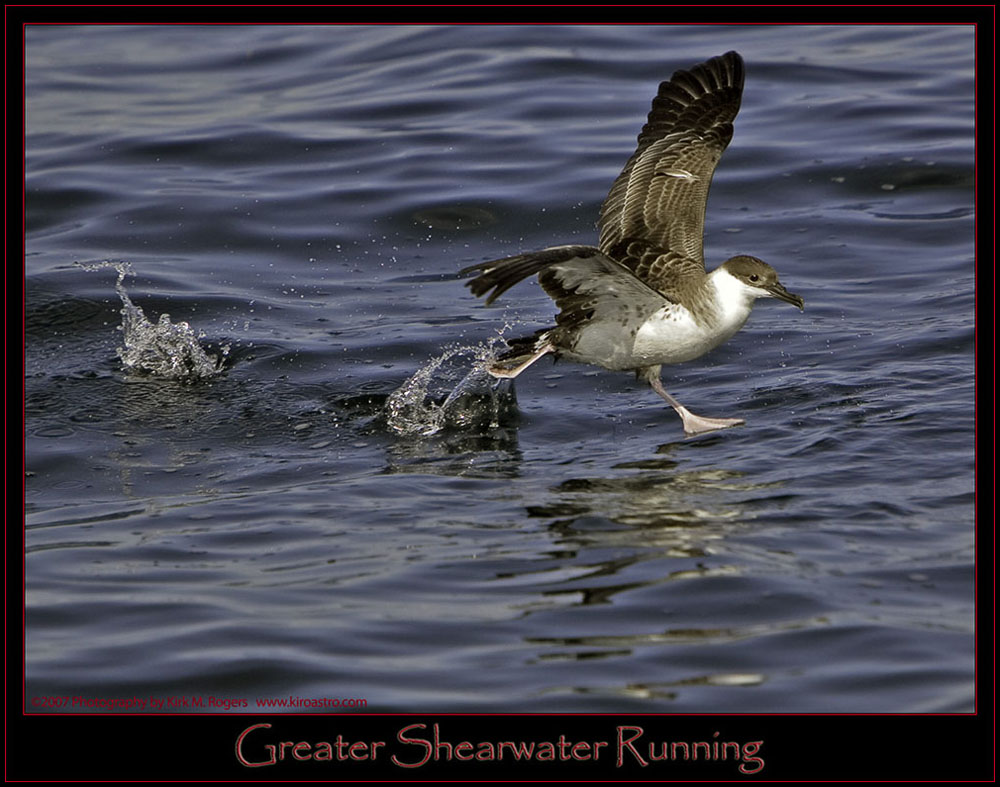
|
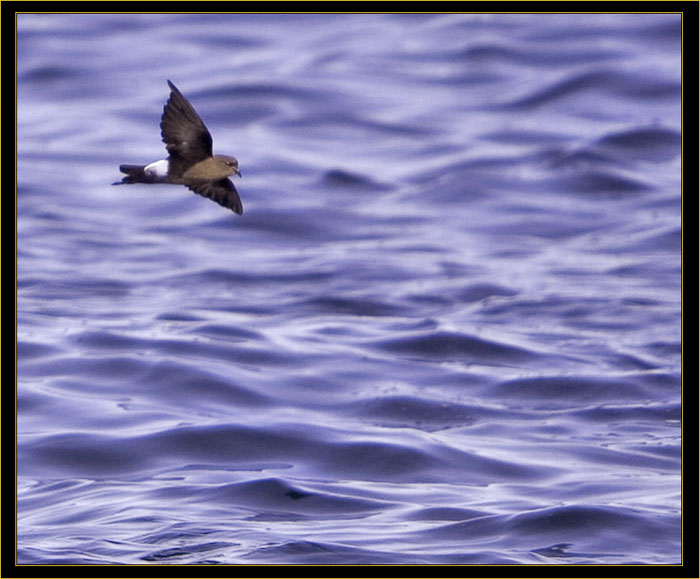
|
I kept seeing several examples of a smallish bird flying around the perimeter of the boat. These birds weren’t joining in the chum fray as far as I could tell, just flying around the area like onlookers. I asked several people near me what these were and never really found out for certain at the time. I considered how best to obtain an image of one, but they were quite small and never really got close from my perspective. Finally during the course of the activity, I heard Derek indicate over the intercom that these were Wilson’s Storm-Petrels. Ah ha – new to my list and definitely a bird I wished to get a photograph of if it could be managed. I didn’t try shooting it a lot as I didn’t think I had much chance of a good exposure. I was pleased with this image at left… According to ‘The Sibley Guide to Birds’ this petrel is only 7.25 inches in body length; this makes it smaller than an American Robin – as stated, I was pleased with this image… |
And no, this isn't close to the final exposure total. Like the gulls, this really is a 'sampling' of these neat birds. Derek and I talked about Shearwaters
and as is the case with many pelagics, he indicated that with legs set far back on their body they need to run along the water to gain enough lift to
take flight. I also noticed they have no problem with running along the surface to get from 'Point A to Point B' if they see something interesting like a piece if chum…

|
|
As the group aboard the Odyssey relaxed a bit, my friend Paul was able to get a spot in the pulpit overhanging the most forward section of the deck.
He really liked it up there - he must have because he didn’t move until we retuned to port. I stayed forward as well for a time. This provided an
opportunity for me to speak with a few folks including one of the spotters, Mike Fahey. Mike is an interesting fellow and we talked about photography
and equipment choices for the endeavor we now engaged in. While we talked, over the intercom came an announcement of a close fly by of a Northern Fulmar.
Mike spotted and pointed out this tubenose as it jetted by. We both got the cameras up; I got one quick and dirty exposure off that I learned later
covered the bird well but missed critical focus. Mike, I hope you got ‘the shot’ Bud – you deserve it..
Paul in the pulpit enjoying the trip
|
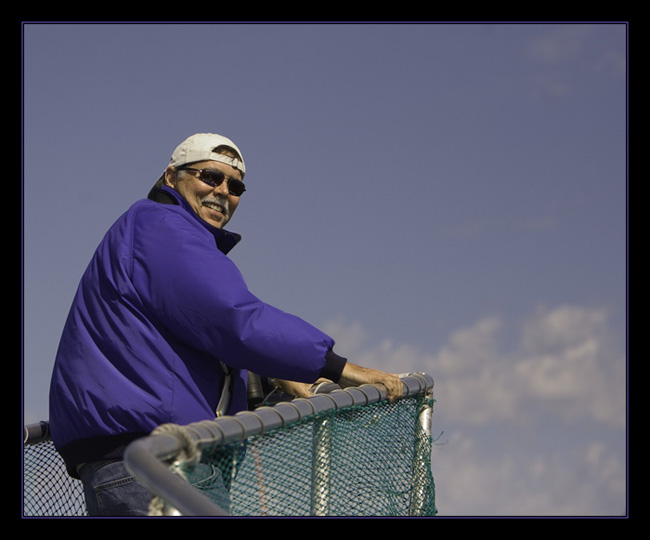
|
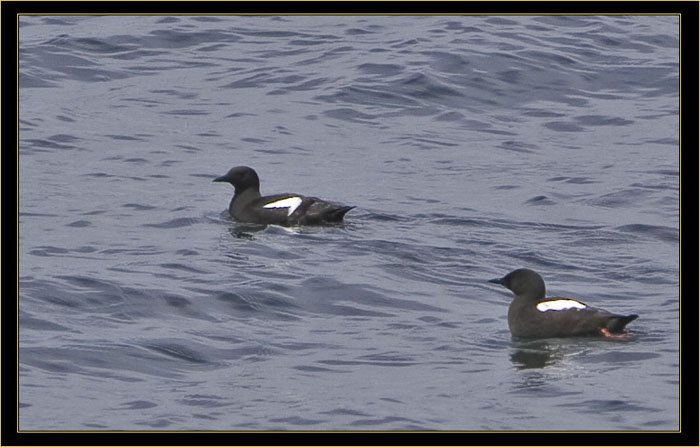
|
By now we were well beyond the halfway mark of the six-hour voyage and headed back to port. Most of the chum had been used up and the fellows were pouring the last of it over the stern as we headed in. I had no complaints; so far it had been an interesting, educational and fun experience. Half a day afloat was fine with me and I had no issue with returning. I hung around with Paul on his pulpit perch and we pointed out a few things along the way as land loomed into view. We returned with the double lighthouses of Two Lights in Cape Elizabeth to port. The bird imaging at this time was similar to the trip out, they were around but distant. A fellow imager came up near the pulpit and we talked for a bit. We spotted some Common Loons and shortly after several Black Guillemots in flight and on the water. These were new to my list and although far distant as we cruised in, I took several shots. The distinctive white wing coverts of the guillemots burned out the highlights in several images as the Sun climbed towards zenith but I had several that were acceptable at this smaller image scale. |
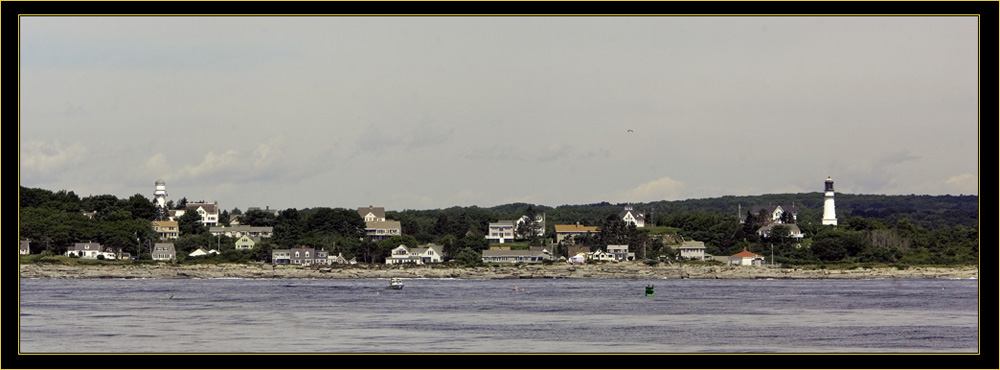
|
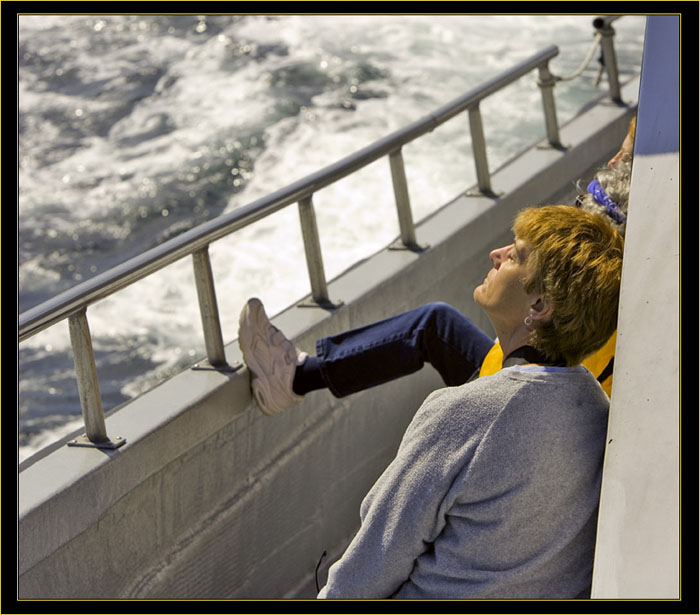
|
Everybody was relaxing and viewing the scenery as Odyssey cruised back to Portland. Linda was taking advantage of the down time to catch a few rays as the morning voyage came to an end. Marlene is out of view in this shot; Paul told me it's her leg in the photo and he should know... |
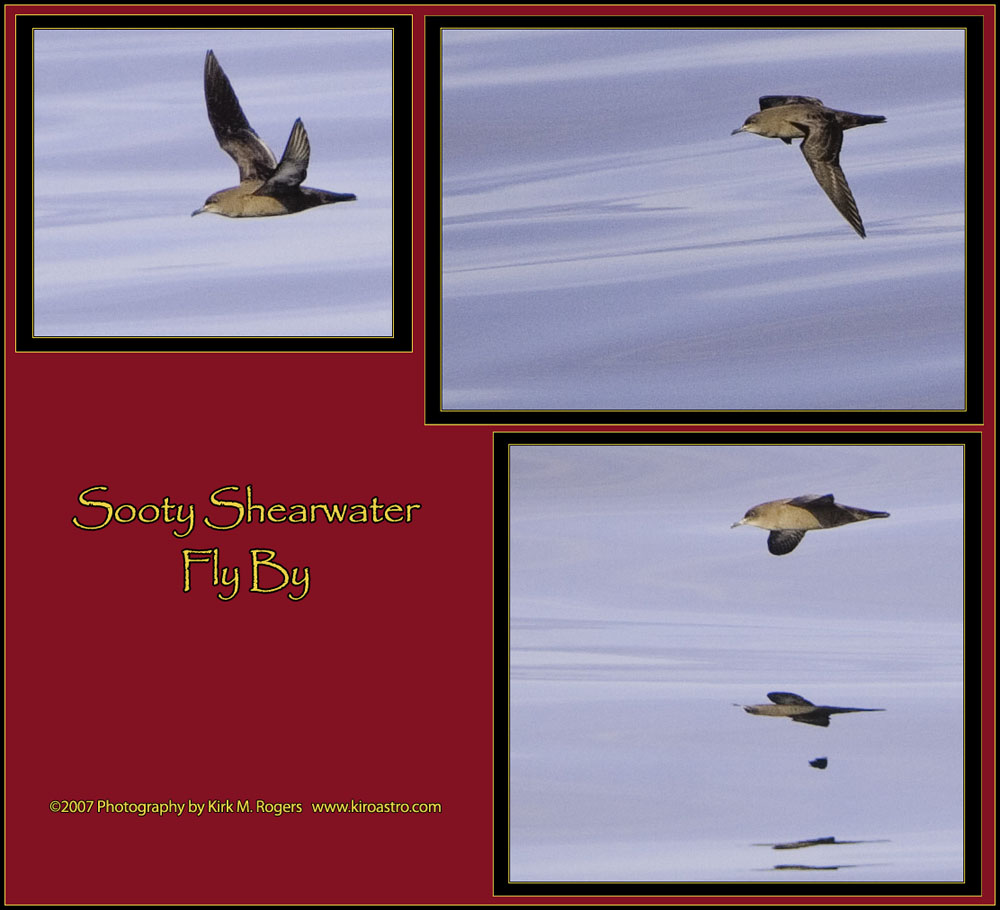
|
| It wasn’t long before the Portland Headlight and the granite structure of the Ram Island Ledge Light hove into view. I'd been hoping to get a few shots of the headlight from sea. I have multiple versions of this light from the park side but this was a different type of opportunity. |
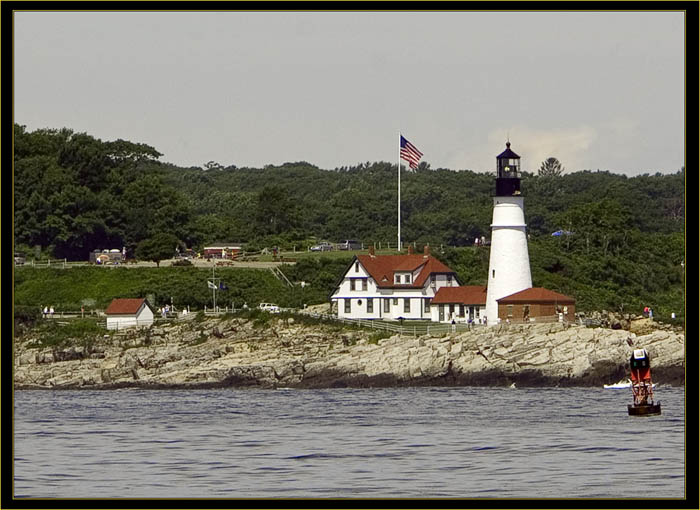
|
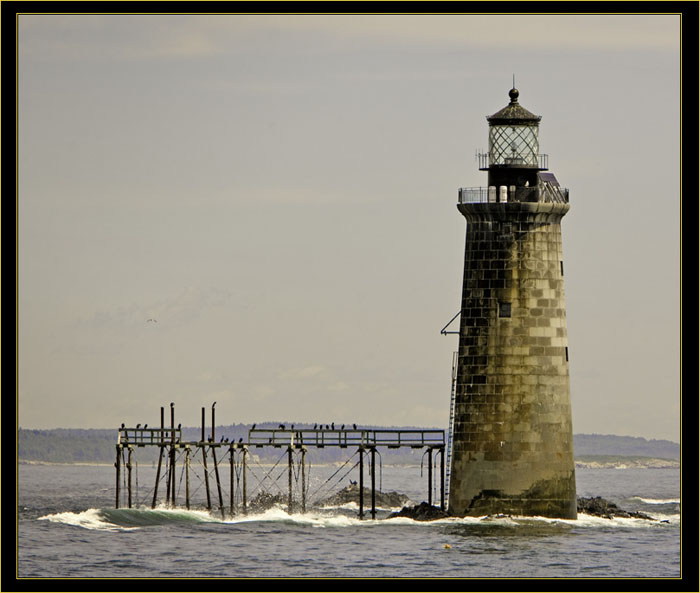
|
I was pleased with the shots I obtained and was also able to achieve good coverage on the Ram Island Light in passing. The photo composition of this light was similar to shooting on land from Fort Williams Park but even with the shorter focal length used aboard Odyssey the image scale was larger. Keep in mind as you view these web images that the master files are large indeed and exhibit wonderful detail. |
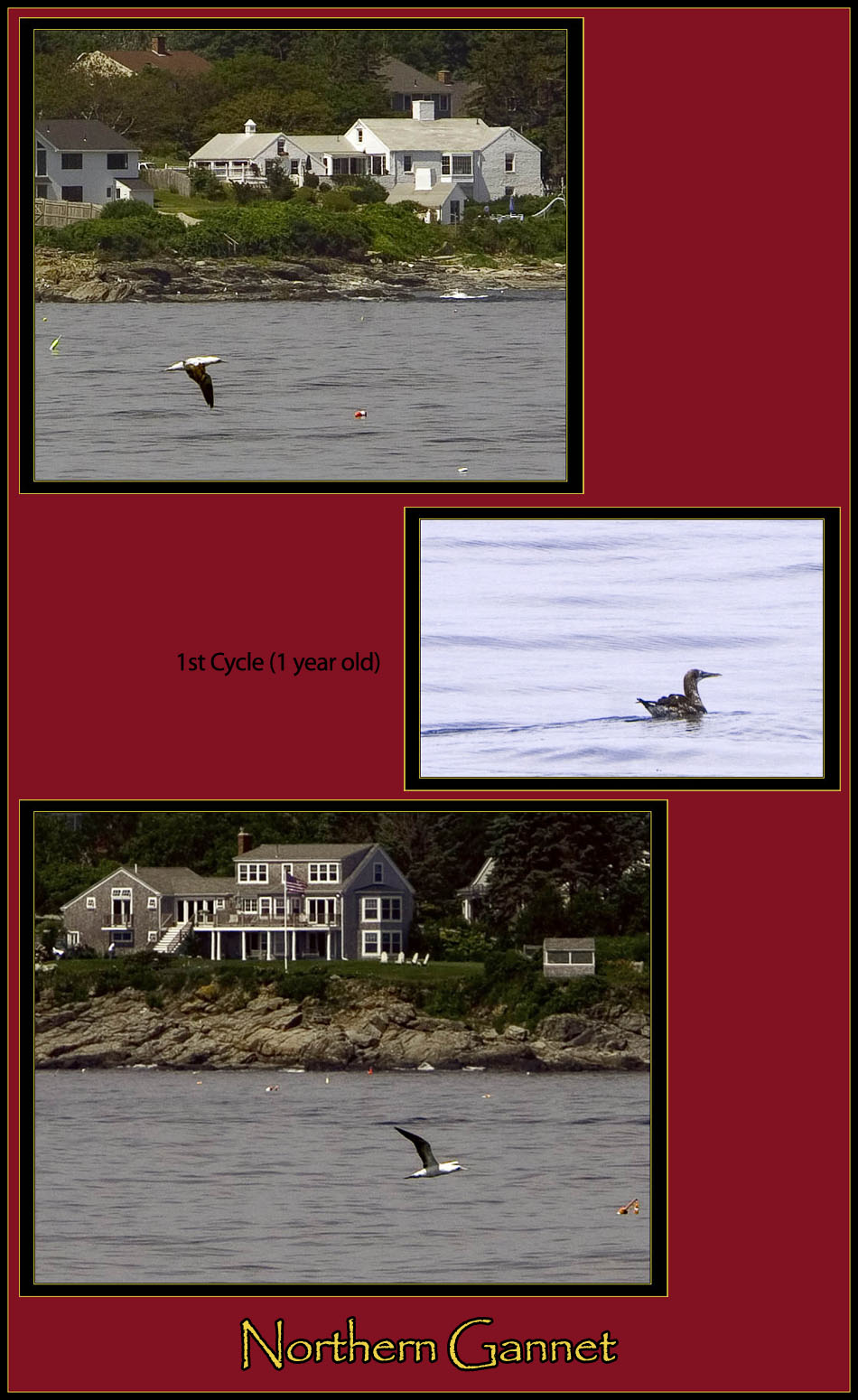
|
| Soon we neared House Island and the fortifications of Fort Scammel. I took several photographs of these on the way by. This is private property and although the public is allowed to view these installations at certain times, this is the best way to get an exposure or two. We were certainly close enough to make this worthwhile. Fort Preble together with Scammel guarded Portland Harbor for many years. The last time either saw any real action was in June of 1863 when Confederate raiders from the CSN Archer, commanded by Lt. Charles W. ‘Savez” Read captured the Union Revenue Cutter Caleb Cushing in Portland and a chase began. The Caleb Cushing was re-taken along with Lt. Read and twenty-two other Confederates, who eventually ended up at Fort Warren in Boston Harbor as prisoners of war. |
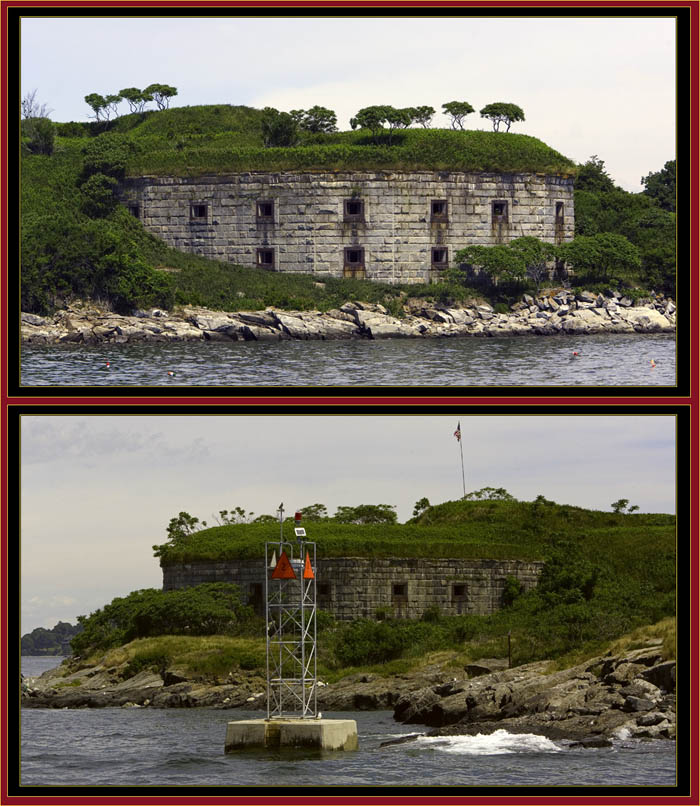
|

|
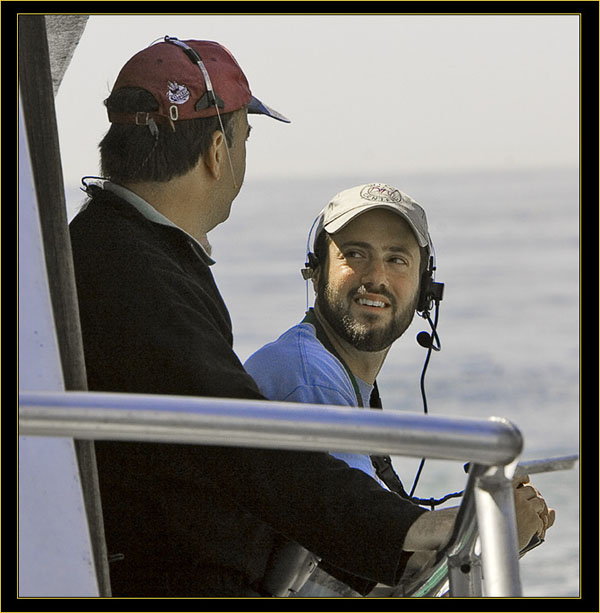
|
Last but far from least as I close this account – let me present the masters of both land and sea – our guides and leaders for the pelagic birding trip, Paul Guris and Derek
Lovitch. I can’t thank you enough for making this successful trip possible…
Should anyone be interested in an adventure similar to what this photojournal describes I urge and recommend you contact Paul and Anita at See Life Paulagics to learn what upcoming trips they may have available. I’m certain when they return to our area they’ll co-sponsor another junket with the Wild Bird Center of Yarmouth. Stop by in Yarmouth to visit Derek and Jeannette when you get a chance; they have all kinds of neat products that are birding and nature related that may draw your attention. And feel free to ask Derek anything – it doesn’t matter what – he’ll probably know the answer in any event… |
Kiro
July 2007